Desert rain falls like a baptismal shower, there is divinity and rebirth. It is a diffuser of an exotic perfume with top notes of fragrant earth, a heart of nostalgia and the base leaving a hint of longing. The desert itself remains almost still, the shifting dunes quivering just a bit in a silent frenzy to quench an insatiable thirst. The rain-washed scrubs gleam black and green. Lightning cracks the shocks of cerulean skies above and thunder squalls trembles the air. The sun, refusing to give in – this is his fiefdom, after all – slants through the tiny clefts of amassing clouds like heavenly spotlight.
Place
I am in Churu, Rajasthan, with its first sightings of the mighty desert. ‘Gateway to the Thar’ is a narrow tourism epithet for here is more grandeur than you can shake a stick at. But rundown, yes. The havelis wear the look of grand old dames fallen on desolate times, deserted by progeny and left to fend for themselves. The bibelot niches were empty and the frescoes, their makeup, were jaded and peeling away. While most of them depicted the usual scenes from the epics, there were a few distinct ones like Dhola and Maru, the Romeo and Juliet of local lore, chased by attackers. There was one of a smoking Jesus; one borne not out of intolerance nor dilettante enthusiasm but playfulness showing the assuredness of artisanship.
The porches were mostly padlocked but peering through the pigeon nets covering the portico, one could see rows and rows of photographs tracing generations and telling stories of riches earned and lost. They were the Marwaris, fabled for their business acumen and affluence, who made the Shekhawati region of Rajasthan, where Churu fell, a Las Vegas during the 18th and 19th centuries – only without the casinos and other elaborate entertainment options. They stood, their bottomless pride twirled into their bristly moustaches and vast wealth reflected on the shiny hoods of their Lincoln Continentals and Chevrolet Impalas. The women remained a deferential step behind, sari draped over their heads. The children scrutinised the camera critically.
Some of these havelis are inhabited – rarely by owners, mostly by caretakers – and they brim with hospitality the region is famed for. Many will invite you inside for a cup of tea and it is generally considered rude to refuse. You may however insist on just water and use the time otherwise spent shooting breeze (the Shekhawati dialect is difficult to follow even for native Hindi speakers; I stood blinking) waiting for the brew with a quick walkabout of the haveli. Remember these are living quarters and do not wander away or open doors on your own. And make it snappy. You enter a large yard as soon as you pass the entry gate. This is where the men conducted their business; women were forbidden here but watched the proceedings from behind regular jaalis or ornate jharokhas depending on your money. In one haveli an old man was still conducting business – he was selling old coins and silver filigreed vases, ivory tobacco boxes, imported cigar cutters and nifty bric-a-brac, remnants of lives well-lived and gone by.
People
Elderly couples sat together, unmoving, probably making up for all the time he was away or she walked behind. Youngsters tackled ennui riding motorcycles at high speeds through winding alleys; their silencer-shorn machines raising a horrendous racket and hair. Shanties were erected in the demesnes by newly-arrived migrant families; babies bawled for milk, women in gilt-spangled saris whupped rotis in al fresco kitchens, looked up and smiled nicely as you walked by. The men folk were already in Gurgaon or Noida – working as drivers or in construction sites. Those who haven’t left milled around the railway station hustling hotels and lodges to the occasional tourist, driving tuk tuks spruced up to look like Cinderella chariots, offering tourist guide and porter services or just sat on their haunches, making plans. Holy men walked in their retreaded shoes towards that other place, casting just a ‘token’ glance at the tohubohu. The heart of the town is mostly businesses that have sprung up around the rail and bus stations. Just one roundabout and turn later you enter the Churu you are here to see. Sandstone ramparts loom over bylanes and alleyways with their crumbling bastions and ornate corbels. Consecutive repairs and repainting have erased the murals from most but some gems can still be seen high above the ground. I had to use my entire zoom to get a good look at the Son of God with a cigarette.
At less than 300 kilometres, the journey from Delhi to Churu is not exactly taxing; I reached well in time to explore the market area converging around the clock tower. Besides household utensils, grocery, freshly ground curry powder, there are scores of shops selling lac bangles for which Churu is famous. Workshops abound in the city outskirts where craftsmen can be seen bent intently over coal fires, laying the lac over wooden rollers. Later I had tea from a dhaba jutting out into a busy lane whose owner claimed to sell more than a thousand cups per day. He also claimed to be pally with local dignitaries and had photographs plastered across his walls for proof. The chai is pretty good but better with the sev and samosa from the snack shop next door. Milk sweet vendors do brisk business, especially the ones near temples. There is one near the Ganga Temple in the market area, their mawa cakes are exceptional. I ate myself sick.
Phenomenon
You are feted at every corner with approving looks – almost like making it to here was a bravura feat. Churu is one of the least visited towns in the otherwise touristy Rajasthan even though it has an illustrious past. The city itself was founded by an eponymous Jat chieftain in 1620 and later fell into the hands of Rajputs from nearby Bikaner. Falling along a popular trade route it was a magnet for the business savvy Marwari merchants, the Seths, who settled here in large numbers with their Sethanis. As business dwindled because of imposition of higher taxes many Marwaris moved shutter and shelter to other parts of India. A prominent family of Seths, called the Poddars, founded Ramgarh 15 km away. The collection of chhatris (cenotaphs) here comes a close second on the grandeur scale after those by the banks of the Betwa in Orchha, Madhya Pradesh. But more colourful with the richly frescoed domes with images from Lord Krishna’s life – most of them still intact! Ask the hotel to arrange for a well-versed guide before you explore Ramgarh; don’t rely on the jejune lads lounging around landmarks.
Locals peg the total number of havelis in and around Churu at not less than a 100, most of them built between the mid-19th and early 20th centuries. A haveli-walk covers the bigger – and more embellished – of the lot, notably the Rajkumar Haveli, Parakh, Kanhaiyalal Bagla, Surana Hawa (with its 1100 windows) and the Malji ka Kamra, an eclectically designed haveli with Venetian and Mughal influences, a heritage hotel today. After the walk one day I went into the Thar the next. Me and a friend slipped over loose scree, trespassed into shepherd hutments gated with dried thistles, ran down the water-harvesting slopes of a desert well and drove up a dune. From the top we espied the endless solitude the gateway opened to. And saw the first flicker of lightning.



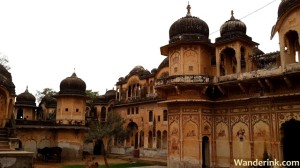
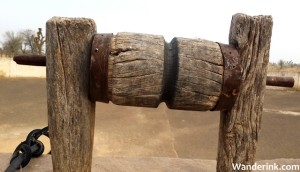
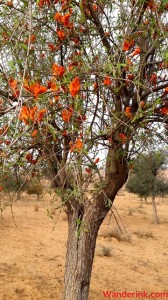
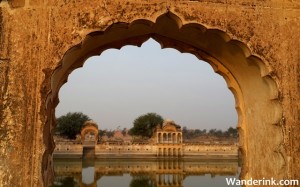
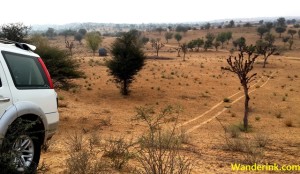









Wow, never heard of the place…thanks for the info. A re-read is a must
You are welcome, Datta.
A new place for me. So much to see.
I would love to do this haveli walk some day!
Sure you must. Keep an eye out on the people too 🙂
I been to this place long time before, it was fun!!.. Memories:)
Great post Jose 🙂
Thank you, bro!
I feel you. Puneetinder, the need for extended stays 🙂
SO beautifully narrated!!!
We look a driving familyholiday in shekhawati and visited bagar, jhunjhunu, nawalgarh….drivign through the shekhwati region is a n experience in itself and then there are the towns….like frazzled robes of a king…splendid but totally worn out at the edges!!!
http://www.myunfinishediife.com
Nicely put, about the Shekhawati region. Couldn’t agree more…just finished a post where I remembered a ride through the region – into Bikaner. Drive safe.
Great piece of information about a historic place named Churu, Rajasthan! I really enjoyed reading about the place, its people, the Haveli and many more things. Surely, many of your readers must have had a great time reading this post. Thanks for sharing it with us.
Thank you Asmita…nice to know you had a good time reading it. I liked the place and the atmosphere so much I am planning to hover around the region the coming weekend – planning to return to Delhi from a Jaipur jaunt via the Shekhawati region.
Nice post. I never heard this all information. Thank you for sharing this wonderful post.
http://www.ankionthemove.com/2016/02/istanbul-blue-mosque-must-visit.html#comment-form
Thank you.
Nice Blog!!! Awesome information about Rajasthan Thanks for sharing.